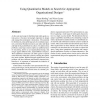56 search results - page 11 / 12 » Flexible Hierarchical Organisation of Role Based Agents |
AAAI
2010
15 years 1 months ago
2010
Multi-Agent Plan Recognition (MAPR) seeks to identify the dynamic team structures and team behaviors from the observations of the activity-sequences of a set of intelligent agents...
ALIFE
2007
14 years 11 months ago
2007
: Reliably recognizing objects approaching on a collision course is extremely important. In this paper, a synthetic vision system is proposed to tackle the problem of collision rec...
125
click to vote
TCBB
2010
14 years 6 months ago
2010
This paper integrates the signal, context and structure features for genome-wide promoter recognition, which is critical in many DNA sequence analysis tasks. First, CpG islands ar...
BMCBI
2010
14 years 11 months ago
2010
Background: Human Immunodeficiency Virus type 1 (HIV-1), the causative agent of Acquired Immune Deficiency Syndrome (AIDS), exhibits very high genetic diversity with different var...
103
click to vote
AAMAS
2008
Springer
14 years 11 months ago
2008
Springer
As the scale and scope of distributed and multi-agent systems grow, it becomes increasingly important to design and manage the participants' interactions. The potential for b...

